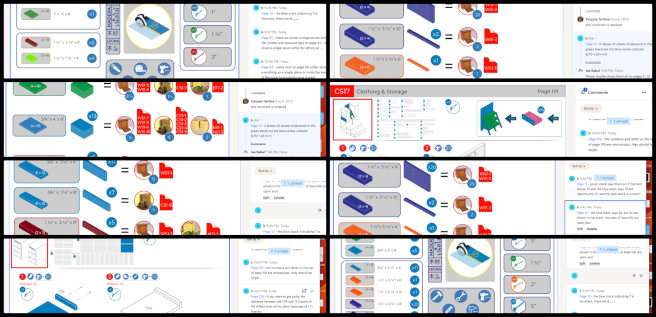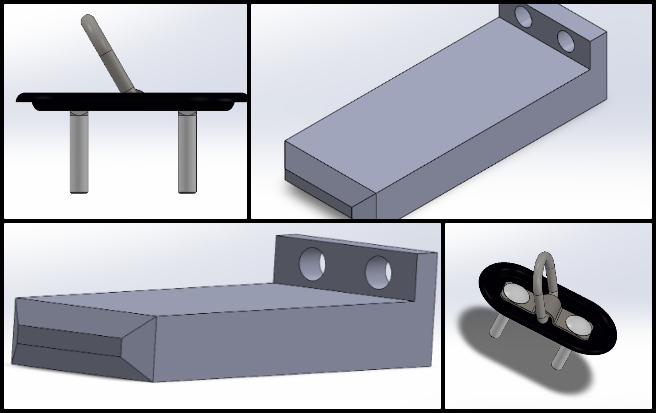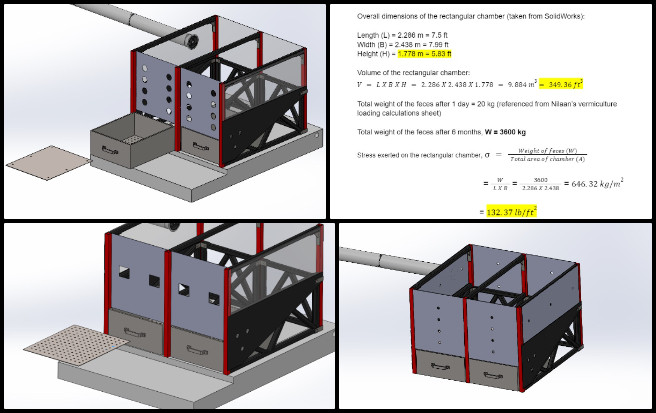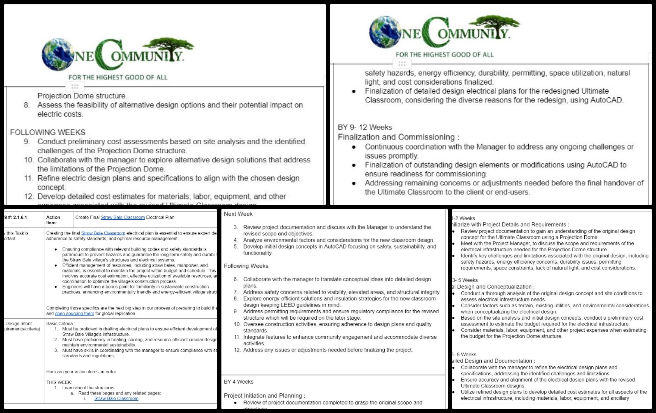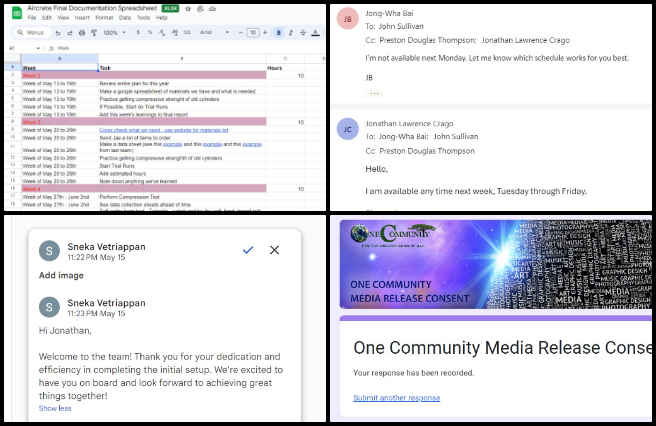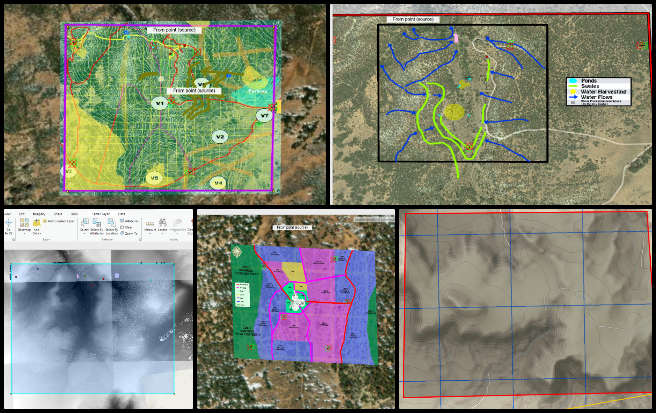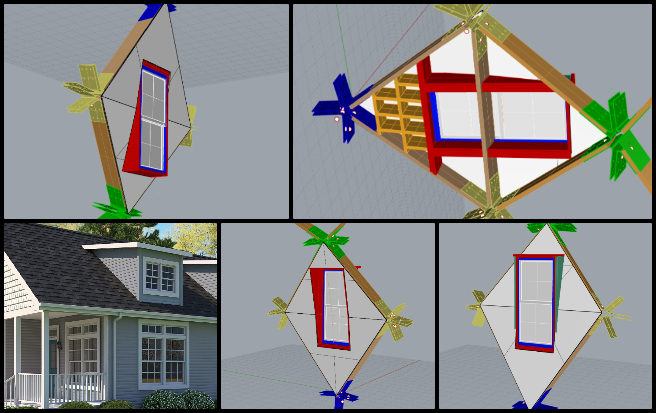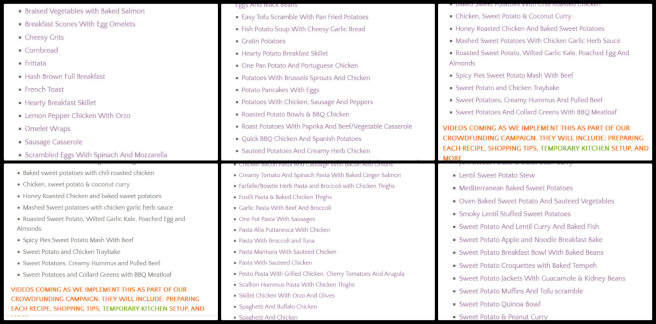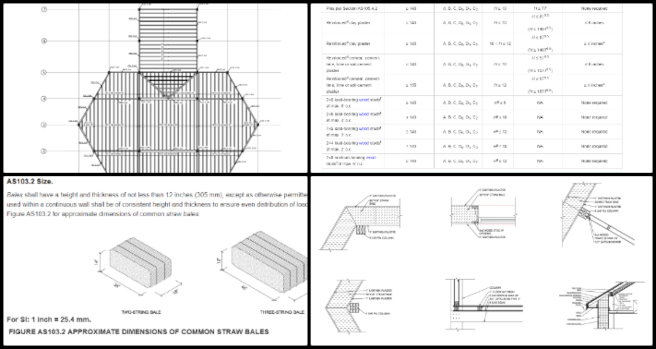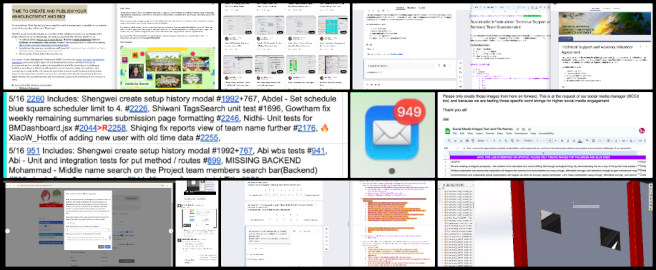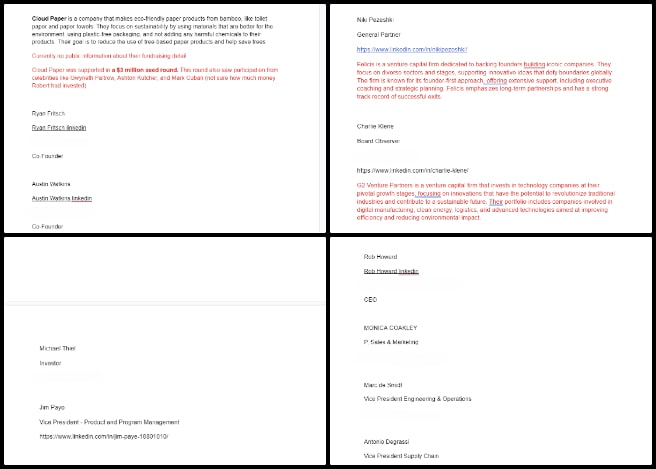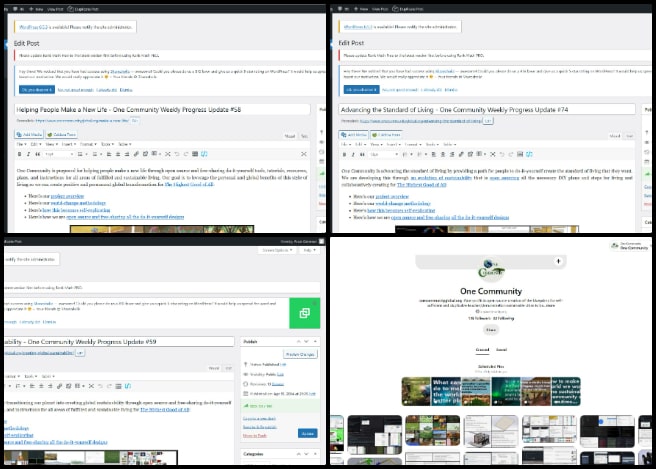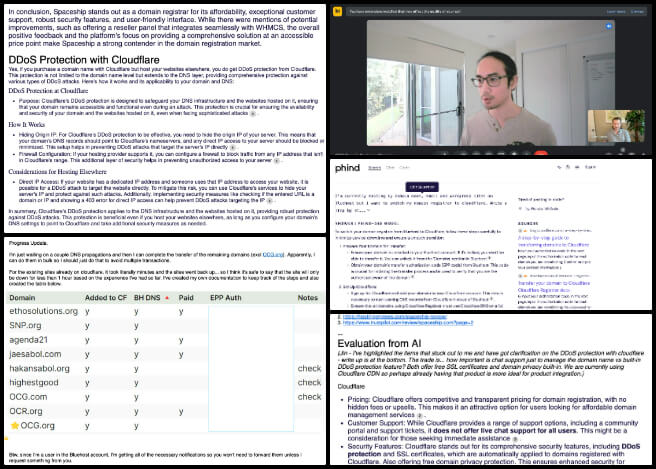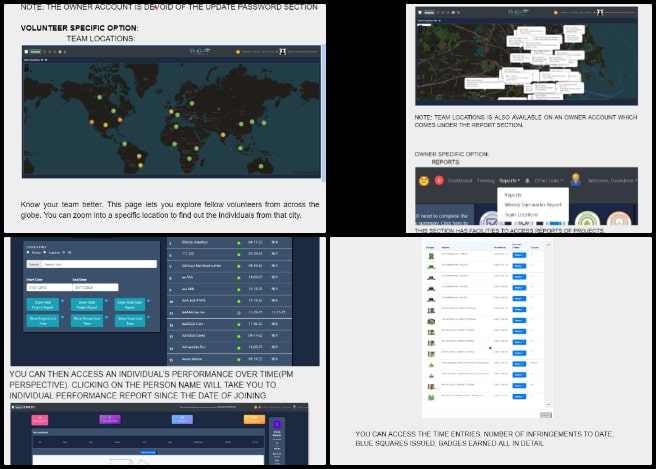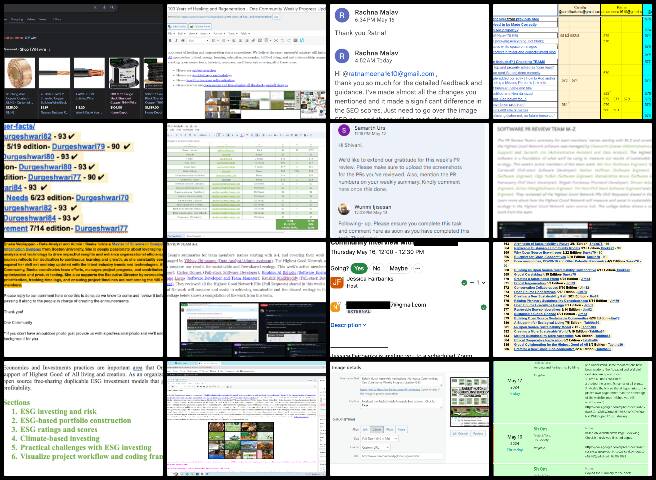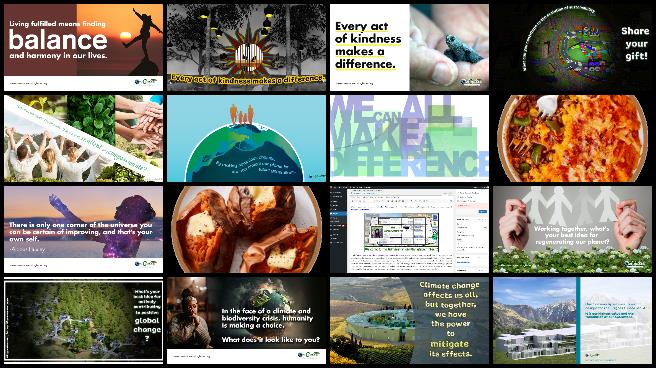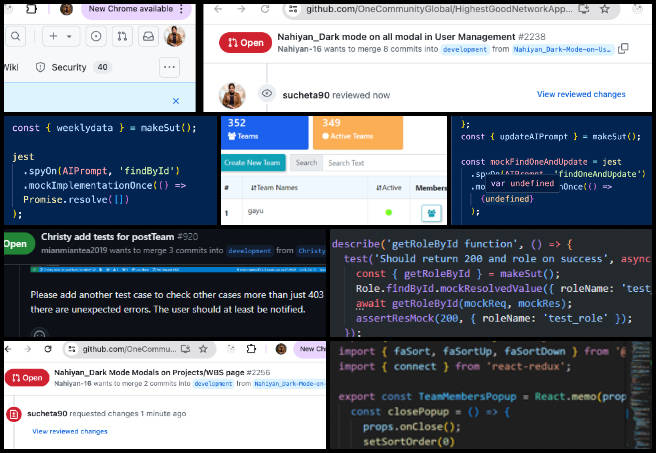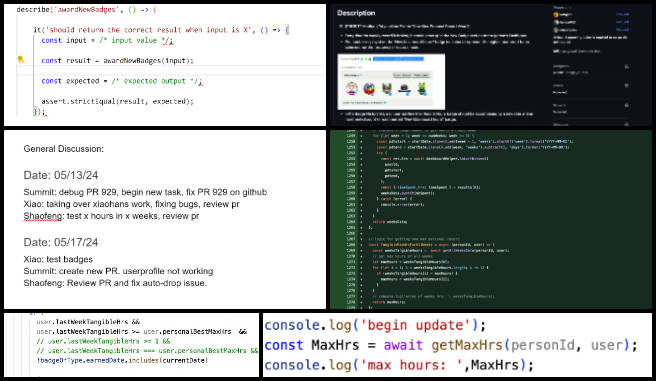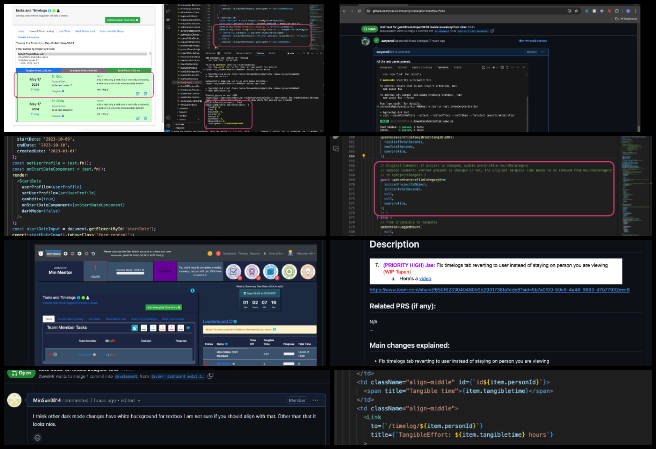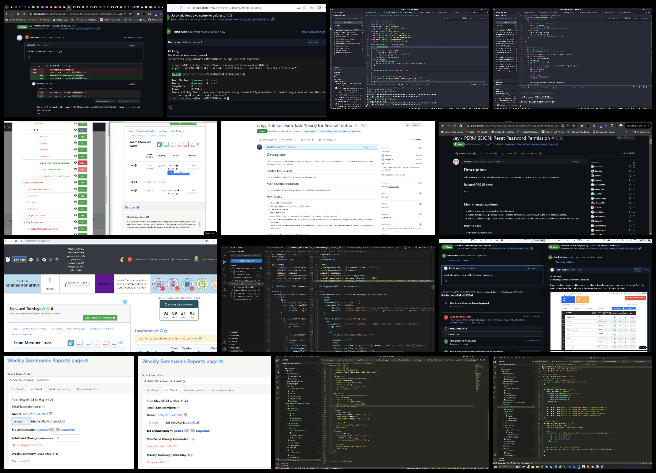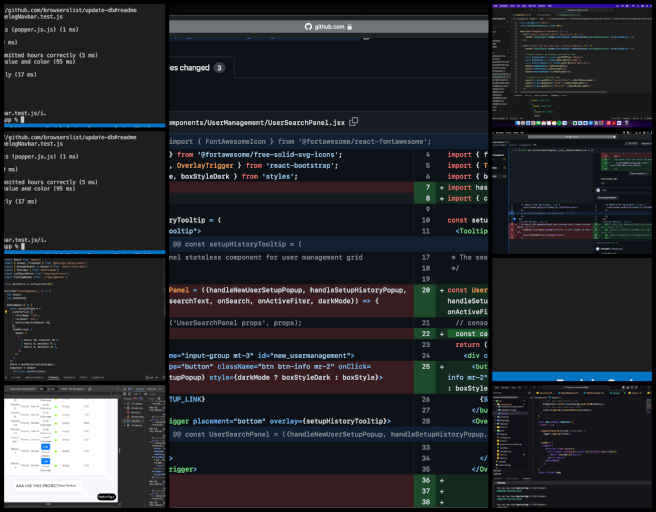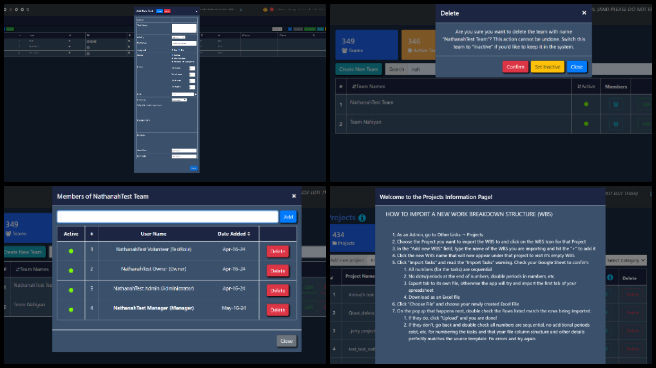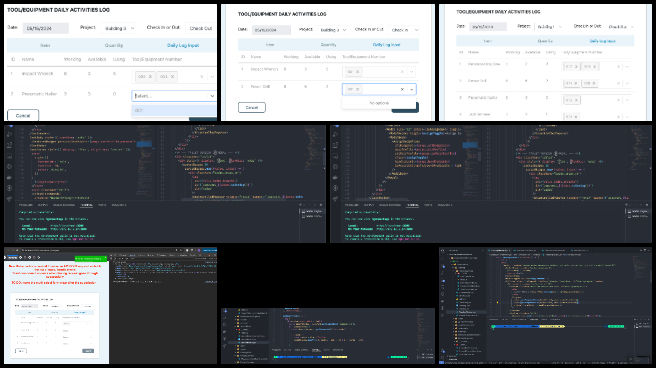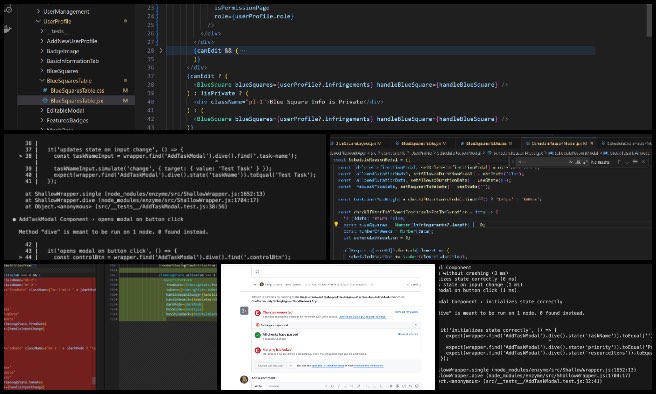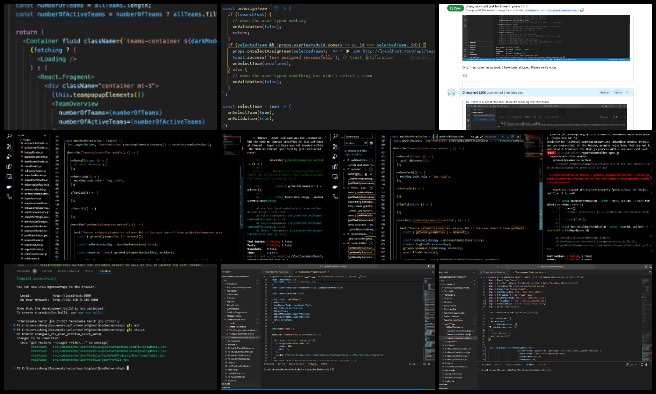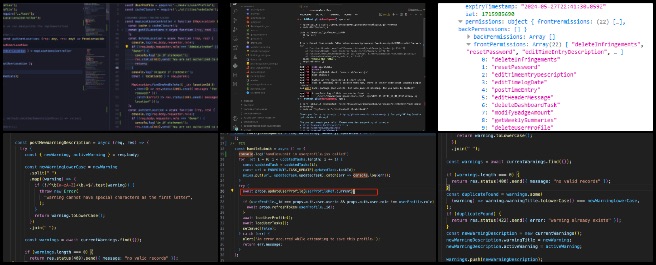Component Assembly for Human Evolution – One Community Weekly Progress Update #583
As an all-volunteer organization, One Community is committed to the process of component assembly for human evolution. We are dedicated to creating sustainable approaches to food, energy, housing, education, economics, and social architecture. Our model, driven by the principle of doing this for “The Highest Good of All” is designed to become self-replicating, fostering a global collaboration of teacher/demonstration hubs. Everything we create is open source and free-shared, created to evolve sustainability, regenerate our planet, and create a world that works for everyone. Join us in our mission towards a brighter future.
- Here’s our project overview
- Here’s our world-change methodology
- Here’s how this becomes self-replicating
- Here’s how we are open source and free-sharing all the do-it-yourself designs

OUR MAIN OPEN SOURCE HUBS
Click on each icon to be taken to the corresponding Highest Good hub page.
One Community’s physical location will forward this example of component assembly for human evolution as the first of many self-replicating teacher/demonstration communities, villages, and cities to be built around the world. This is the May 20th, 2024 edition (#583) of our weekly progress update detailing our team’s development and accomplishments:
Component Assembly for Human Evolution
One Community Progress Update #583
DONATE | COLLABORATE | HELP WITH LARGE-SCALE FUNDING
CLICK HERE IF YOU’D LIKE TO RECEIVE AN EMAIL EACH WEEK WHEN WE RELEASE A NEW UPDATE
YOU CAN ALSO JOIN US THROUGH SOCIAL MEDIA
ONE COMMUNITY WEEKLY UPDATE DETAILS
HIGHEST GOOD HOUSING PROGRESS
 One Community is facilitating component assembly for human evolution through Highest Good housing that is artistic and beautiful, more affordable, more space efficient, lasts longer, DIY buildable, and constructed with healthy and sustainable materials:
One Community is facilitating component assembly for human evolution through Highest Good housing that is artistic and beautiful, more affordable, more space efficient, lasts longer, DIY buildable, and constructed with healthy and sustainable materials:
- Learn about: Our Upcoming Crowdfunding Campaign
- Learn about the different village models as part of component assembly for human evolution: 7 Sustainable Village Models
- Visit the open source portals for the first two: Earthbag Village OS Hub | Straw Bale Village OS Hub
This week, the core team reviewed sections of the “Murphy Bed” document, ensuring that the listed quantities of lumber correspond precisely with the written instructions for the lumber stacks. Additionally, they continued updating and expanding the Highest Good Food tools, equipment, materials, and supplies document by adding new items, descriptions for each item and categorizing each item. They expanded the tool list and initiated a formatting overhaul to align it with the structure of previous tool lists. DIY furniture and Highest Good food are an important part of component assembly for human evolution with One Community’s open source plans. See our work in the collage below.
Joseph Osayande (Mechanical Engineer) continued helping finish the Vermiculture Toilet designs. His objective was to finalize calculations in feet for each quadrant of the container when full and for the drawers when full. The amount of force required to pull out the steel metal separator was determined, and a D-ring was identified as a solution for the winch to connect to as the pulling mechanism. Sketches were created for the object that would support and act as an attachment for the winch to the main container, allowing it to move around when pulling out the metal separator. Further research was made on winch operation and the realistic force capabilities, and different types of winches were analyzed. The vermiculture toilets and other sustainable human waste processing technologies form the basis of One Community’s open source component assembly for human evolution model. See below for some of the pictures related to this work.
Rizwan Syed (Mechanical Engineer) also continued helping finish the Vermiculture Toilet designs. He resumed with design iterations of One Community’s vermiculture eco-toilet chamber system. He redesigned the pull handle of the removable drawer to allow bolts to be inserted from the inside, enhancing the assembly’s maintainability. The processing chamber container was replaced with a long rectangular sheet, and viewport holes were added at one-foot intervals vertically to monitor the vermicomposting process. Rizwan also researched options for installing rubber plugs to cover these cutouts, aiming to improve the system’s sealing capabilities. Additionally, he updated his hand calculations for the maximum loading on the chamber system, taking into account the accurate vertical height from the lower toilet to the topmost ceiling of the vermiculture toilet. The vermiculture toilets and other sustainable human waste processing technologies form the basis of One Community’s open source component assembly for human evolution model. Here are a few photos showing examples of his work.
Sajal Shah (Project Manager) continued managing completion of the Highest Good Energy components. She revised and developed a new Work Breakdown Structure (WBS) for the Straw Bale classroom project, ensuring that all tasks and milestones are clearly defined and organized. Additionally, Sajal was in charge of an interview with a candidate for the plumbing designer position, evaluating the candidate’s qualifications and fit for the role. The Highest Good Energy is an essential component of One Community’s open source component assembly for human evolution model. See below for some of the pictures related to this work.
AIRCRETE TEAM
The Aircrete Testing Team’s summary, covering their work on Aircrete Compression Testing was managed by John Sullivan (CBU Chemical Engineering Student) and includes Jonathan Crago (Civil Engineering Student) and Preston Thompson (Civil Engineering Student). This week, John and Preston examined the inventory and assessed the team’s requirements, confirming the availability of all necessary materials for the project. Together, they began compression tests using old cylinders and practiced creating foam with an air compressor. Jonathan nearly completed the orientation document for his team, collaborated with John and Preston to develop a general schedule for the summer, emailed Dr. Bai to arrange a meeting to discuss aircrete foam disposal, and agreed to participate in media coverage. Preston further researched aircrete and foam to deepen his understanding of the process. The team’s efforts form the basis of One Community’s open source component assembly for human evolution. See below for some of the pictures related to this work.
DUPLICABLE CITY CENTER PROGRESS
 One Community is facilitating component assembly for human evolution through a Duplicable and Sustainable City Center that is LEED Platinum certified/Sustainable, can feed 200 people at a time, provide laundry for over 300 people, is beautiful, spacious, and saves resources, money, and space:
One Community is facilitating component assembly for human evolution through a Duplicable and Sustainable City Center that is LEED Platinum certified/Sustainable, can feed 200 people at a time, provide laundry for over 300 people, is beautiful, spacious, and saves resources, money, and space:
- Learn about this building and its function as part of component assembly for human evolution: Duplicable City Center Open Source Hub
This week, Chris Blair (GIS Technician/Horticulturist) continued working with GIS data as part of One Community’s Permaculture Design. He reviewed Ben’s files and familiarized himself with One Community’s permaculture web page. He imported images involving the master plan into ArcGIS Pro and georeferenced them. Additionally, Chris found digital surface models (DSM) of the property on a government website, imported them into ArcGIS Pro, and combined the sections into a cohesive raster mosaic dataset covering the property. Proper property modeling and understanding is a foundational part of One Community’s open source component assembly for human evolution model. Here are a few photos showing examples of his work.
Nika Gavran (Industrial Designer) continued her work on the Duplicable City Center dormer window installation plans. She focused on improving the structural integrity of the first-floor dormer window. She identified issues in the previous CAD design that resulted in an unstable structure and transitioned the design from a classic dormer window to a shed dormer, which better suits the dome structure. Nika also completed a version of the window using wood pieces available in hardware stores. The Duplicable City Center is a foundational part of One Community’s open source component assembly for human evolution model. See below for some of the pictures related to this work.
HIGHEST GOOD FOOD PROGRESS
 One Community is facilitating component assembly for human evolution through Highest Good food that is more diverse, more nutritious, locally grown and sustainable, and part of our open source botanical garden model to support and share bio-diversity:
One Community is facilitating component assembly for human evolution through Highest Good food that is more diverse, more nutritious, locally grown and sustainable, and part of our open source botanical garden model to support and share bio-diversity:
- Learn about these structures and their function as part of component assembly for human evolution: Hoop House Hub | Aquapini & Walipini Open Source Hub
- See what we’ll be growing: Gardens & Hoop Houses | Large-scale Structures | Food Forest | TA
This week, Charles Gooley (Web Designer) continued to work on various recipes as part of the Transition Food Self-sufficiency Plan. He continued to work on the recipes project, focusing on generating tables of contents for various recipe categories, including Vegan Sweet Potato Yam recipes, Omnivore Miscellaneous recipes, Omnivore Pasta recipes, Omnivore Potato recipes, and Omnivore Sweet Potato recipes. Placeholder images will be replaced with the provided images, and remaining content for the recipe pages will be posted upon receipt. Highest Good food is an important part of component assembly for human evolution with One Community’s open source plans. See his work in the collage below.
Hayley Rosario (Sustainability Research Assistant) continued helping finalize the Highest Good Food rollout plan and reviewed the Integration and Highest Good Food tools and equipment document. She was assigned to check the order, image, and description on the Highest Good Food document. With the Integration document, she attempted to research additional links and examples to use, but was unsuccessful. Highest Good food is an important part of component assembly for human evolution with One Community’s open source plans. See her work in the collage below.
HIGHEST GOOD EDUCATION PROGRESS
 One Community is facilitating component assembly for human evolution through Highest Good education that is for all ages, applicable in any environment, adaptable to individual needs, far exceeds traditional education standards, and more fun for both the teachers and the students. This component of One Community is about 95% complete with only the Open Source School Licensing and Ultimate Classroom construction and assembly details remaining to be finished. With over 8 years of work invested in the process, the sections below are all complete until we move onto the property and continue the development and open sourcing process with teachers and students – a development process that is built directly into the structure of the education program and everything else we’re creating too:
One Community is facilitating component assembly for human evolution through Highest Good education that is for all ages, applicable in any environment, adaptable to individual needs, far exceeds traditional education standards, and more fun for both the teachers and the students. This component of One Community is about 95% complete with only the Open Source School Licensing and Ultimate Classroom construction and assembly details remaining to be finished. With over 8 years of work invested in the process, the sections below are all complete until we move onto the property and continue the development and open sourcing process with teachers and students – a development process that is built directly into the structure of the education program and everything else we’re creating too:
- Program Overview as part of component assembly for human evolution: Education Open Source Hub
- How the components work together as part of One Community’s component assembly for human evolution: How to use the Education for Life Program
- Lesson Plans for Life “Ò Lesson Plans How-to
- Foundations of Outstanding Leaders, Teachers, and Communicators
- Curriculum for Life
- Teaching Strategies for Life
- Learning Tools and Toys for Life
- Evaluation and Evolution
This week, Apoorv Pandey (Mechanical Engineer) continued helping with the engineering details for the The Ultimate Classroom part of the Highest Good Education component. He documented all completed work in a centralized location, performed calculations for the updated frame of the entire structure in STAAD Pro, and made calculations for the main roof truss in STAAD Pro. He also continued updating the title block in AutoCAD to meet State requirements and made additional modifications to ensure compliance with these specifications. The One Community model of combining forward-thinking education with sustainably built classrooms like this are another example of component assembly for human evolution. See the collage below for his work.
HIGHEST GOOD SOCIETY PROGRESS
 One Community is facilitating component assembly for human evolution through a Highest Good society approach to living that is founded on fulfilled living, the study of meeting human needs, Community, and making a difference in the world:
One Community is facilitating component assembly for human evolution through a Highest Good society approach to living that is founded on fulfilled living, the study of meeting human needs, Community, and making a difference in the world:
- Read the Highest Good society overview: Highest Good Society
- Learn about the model for fulfilled living and sharing as part of component assembly for human evolution: A Day in the Life
- Learn about the 4 economic models and their part of component assembly for human evolution: RBE | For-profit | Non-profit | Entrepreneurship
- Learn about our open source community collaboration and management software: The Highest Good Network
This week, the core team completed over 50 hours managing One Community volunteer-work review not included above, emails, social media accounts, web development, new bug identification and bug-fix integration for the Highest Good Network software, and interviewing and getting set up new volunteer team members. They also shot and incorporated the video above that talks about component assembly for human evolution and how component assembly for human evolution is a foundation of the bigger picture of everything One Community is doing. The pictures below shows some of this work.
Aaron Wang (Fundraising Assistant) continued his in-depth research on connections with Robert Downey Jr., uncovering emails, LinkedIn profiles, and background information of individuals who may be connected to Downey. His goal is to enhance connections with funders by establishing relationships with relevant individuals involved in these networks. Additionally, Aaron focused on identifying candidates with investor backgrounds, aiming to broaden the channels through which funding can be accessed. His efforts demonstrate a strategic approach to deepening networking opportunities and expanding potential funding sources within the philanthropic sector bolster One Community‘s goal for component assembly for human evolution. The following images highlight his progress for the week.
Arun Chandar Ganesan (Volunteer Data Analyst and SEO and Social Media Assistant) continued his work related to social media scheduling for Facebook and Instagram. He worked on multiple webpages, focusing on the SEO work completed by other volunteers. He checked and verified approximately 40 pages and also revisited and cleared some previously abandoned pages. Additionally, Arun began learning how to post on Pinterest and continued scheduling content on that platform. His work on social media helps One Community to broaden their reach and spread their message about component assembly for human evolution. The following images show his work for the week.
Jin Hua (Website, AdWords, and Analytics Administrator) worked on helping move our domains from BlueHost to CloudFlare. BlueHost has raised prices on us every other year for the past several years. This move will stop this and cut our costs by over 50%. See below for images related to this.
Prashanth Gowri Shankar Uppudi (Admin and Project Manager) continued work on the user manual, while progressing with other sections. He enhanced the user manual interface’s menu bar and created a comprehensive section dedicated to profile visits, project reports, and team summaries. His work included refining content associated with team locations and additional functionalities exclusive to the owner account, with a particular focus on enriching the reports section. In the teams component of the reports section, he introduced features that allow activity selection based on diverse filters and facilitated the integration of performance charts. Prashanth also updated the projects section of the manual, improving the presentation of current information and ensuring it covered all necessary aspects of the reporting features available to the owner. This included incorporating weekly summaries accessible over extended periods and carefully selecting and updating images to meet established criteria. Development of the user manual makes it easier for One Community to train their volunteers to execute their plans for ideating the component assembly for human evolution. The images below display his work for the week.
ADMINISTRATION TEAM
The Administration Team’s summary, covering their work administrating and managing most of One Community’s ongoing process for component assembly for human evolution was managed by Vriddhi Misra (Admin and Marketing Assistant) and includes Durgeshwari Naikwade (Data Analyst), Jessica Fairbanks (Administrative Assistant), Jim Zhang (Administrative Assistant), Olawunmi “Ola” Ijisesan (Administrative and Management Support), Rachna Malav (Data Analyst), Ram Shrivatsav (Data Analyst and Admin assistant), Ratna Meena Shivakumar (Data Analyst and Admin), Ruiqi Liu (Administrative Assistant), Sneka Vetriappan (Data Analyst), T R Samarth Urs (Data Analyst), Vibhav Chimatapu (Data Analyst/Admin Assistant), Xiaolai Li (Administrative Assistant), and Zuqi Li (Administrative Assistant and Economic Analyst). This week, Durgeshwari progressed on HR metrics analytics by creating a new dummy dataset and designing a mockup dashboard for volunteer stats in collaboration with the software development team. She also optimized SEO for 10 blogs, gave interviews for the software development team, and provided feedback to guide new volunteers. Jessica initiated the drafting of work breakdown structures for multiple volunteer roles, and arranged and completed an interview with a prospective volunteer, while managing her routine administrative duties.
Jim posted weekly blog updates, completed SEO for the first 10 blogs, worked on the electrical cost analysis for the earthbag project, and finished the electrical cost analysis for the net-zero bathroom project, which is now awaiting review. Ola reviewed the work of PR team members, provided feedback, tracked progress reports for accuracy and documentation, and assisted with volunteer training feedback. Rachna did her part helping with component assembly for human evolution as she handled administrative tasks, provided feedback to team members, created the weekly blog, reviewed the work of other administrators, scheduled interviews, met with candidates, and improved SEO scores on assigned pages.
Ram focused on refining SEO articles, updating a blog post-PDF, and assisting with the initial training of new volunteers. Ratna did her part helping with component assembly for human evolution as she reviewed the weekly progress update, prepared collages, scheduled and gave interviews, managed correspondence, and gave feedback on blogs. Ruiqi completed reviews for the Dev Dynasty and Expresser teams, created collage images, generated SEO keywords, helped with new admin training, and modified the Aquapini and Walipini Cost Analysis spreadsheet for readability. Sneka added weekly summaries and collages to a webpage, reviewed time log entries, provided feedback, and worked on improving SEO pages.
Samarth managed the PR review team, changed blog posts for SEO optimization, and adjusted his blog based on feedback. Vibhav reviewed the PR Team’s work, created group summaries and collages, and achieved notable results in webpage SEO optimization. Vriddhi assigned and reviewed blog tasks, compiled summaries, and created collages for the admin team. Xiaolai organized documents, edited summaries, completed the weekly report, assisted with trainee reviews, contributed to a solar energy project, and initiated a project on ESG sustainable investments. Zuqi organized weekly summaries, updated the weekly blog, reviewed past optimized blogs, provided guidance to new admins, and reviewed their action items. One Community’s model for component assembly for human evolution includes developing and maintaining a huge administration team like this. You can see the work for the team in the image below.
GRAPHIC DESIGN TEAM
The Graphic Design Team’s summary was managed by Zuqi Li (Administrative Assistant and Economic Analyst) and included Ashlesha Navale (Graphic Designer), Britney Robles (Graphic Designer), Nancy Mónchez (Graphic Designer), Shayan Afkari (Graphic Designer) and Zixi Zhang (Graphic Designer), covering their work on graphic designs for component assembly for human evolution. Ashlesha focused on producing thirty recipe images for the Master Recipe SWG, Master Recipe SWH, Master Recipe SFWI, and Master Recipe FWG, as well as curated a collection of nature-based and theme-based background images for social media content. Britney selected imagery and phrases, creating illustrations to augment One Community’s social media presence, utilizing both stock photos and original designs to enhance engagement. Nancy worked on refining existing images, emphasizing typography over visuals for certain Facebook publications, while also drafting grammatically accurate questions for social media posts.
Shayan created over six images with advanced techniques like masking and color adjustments, and also designed biographical profiles for web content. Zixi contributed ten social media images, employing varied composition designs and a cohesive green color scheme across different platforms. Zixi worked on Sneka’s profile image, bio image, and announcement page using WordPress and Photoshop. See the Highest Good Society pages for more on how this contributes to component assembly for human evolution. See the collage below to view some of their work.
HIGHEST GOOD NETWORK PROGRESS
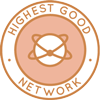 One Community is facilitating component assembly for human evolution through open source Highest Good Network® software that is a web-based application for collaboration, time tracking, and objective data collection. The purpose of the Highest Good Network is to provide software for internal operations and external cooperation. It is being designed for global use in support of the different countries and communities replicating the One Community sustainable village models and related components.
One Community is facilitating component assembly for human evolution through open source Highest Good Network® software that is a web-based application for collaboration, time tracking, and objective data collection. The purpose of the Highest Good Network is to provide software for internal operations and external cooperation. It is being designed for global use in support of the different countries and communities replicating the One Community sustainable village models and related components.
- Learn about this open source community collaboration and management software and its relation to component assembly for human evolution: The Highest Good Network
This week, the core team continued their work on the Highest Good Network PRs testing, confirming the fixed PRs. This included edit time entry tracking and blue square function (PR2131), making Jae’s accounts editable only by each other (PR 1681 + 649), ensuring manually assigned badges show up on pages (PR 666), and changing button colors of the team members’ task component (PR 2145). They identified unresolved issues, such as checking and fixing the “X hours in one week” badges (PR802), noting that no icon appears on the Weekly Summaries Reports page next to the user name, although the badge earned last week displays the correct number of hours, “30 hours” (logged 39 hours). Additionally, they reported a new bug related to discrepancies in total hours committed to the project when viewing reports from different accounts, tested and confirmed an issue with the very slow loading of the members list on the Project report page (taking 1 minute and 12 seconds), and checked all PRs marked as DONE that were merged into the main branch, stopping on page 73. See the Highest Good Society and Highest Good Network pages for more on how this relates to component assembly for human evolution. The collage below shows some of their work.
ALPHA SOFTWARE DEVELOPMENT TEAM
This week, the Alpha Team’s summary, covering their work on the Highest Good Network software was managed by Sucheta Mukherjee (Software Developer) and includes Gayathridevi Chithambaram (Full Stack Developer), Jordy Corporan (Software Engineer), and Lin Khant Htel (Frontend Software Developer). The Highest Good Network software is how we will manage and objectively measure our processes for component assembly for human evolution across our social architecture, construction, production, and maintenance processes. This week, Gayathridevi focused on implementing a limit-see-all checkbox within the teams feature, which restricts the visibility of team members so that only designated individuals within the team have access to view all other members. This functionality is being developed to facilitate the creation of teams with members requiring specialized support within a controlled group environment, preventing these members from viewing each other even if they belong to different teams.
Lin approved eight pull requests on the HGN GitHub repository, wrote unit tests for the DashboardController, addressed some failed test cases. Additionally, Lin worked on weekly data testing and gained substantial knowledge about unit testing, MongoDB aggregation, and integration testing. The pull requests included Gowtham’s fix on the Weekly Remaining Summaries submission page formatting (#2246), Jordy’s fix on ES6 export syntax (#944), Nahiyan’s dark mode on Badge Management Page Modals (#2243), Weiyao’s permission management for creating users (#2252), Peterson’s bug fix related to an error after searching for a user (#948), Ramakrishna’s creation of different views for the summary (#2259), Nahiyan’s dark mode modals on the Teams Page (#2261), and Imran’s feature to see users in projects (#2263).
Jordy expanded his proficiency in unit testing, focusing particularly on Jest while developing tests for the OwnerMessageController and rolesController. He also reviewed PR#920, provided feedback, and finalized the unit tests for the OwnerMessageController and rolesController to ensure clean and well-structured code. Sucheta did her part helping with component assembly for human evolution as she primarily focused on learning Redux and its implementation. She reviewed PR 2238, which was supposed to implement dark mode for the Owner’s account, specifically for User Management modals; most features worked as expected, but a comment was left regarding an issue where dark mode resets to light mode upon page refresh. PR 2256 was reviewed, noting an issue where dark mode changes were not consistent between pages, reverting to light mode on navigation or refresh, potentially leading to a poor user experience; aside from this, the modals looked fine. PR 2259, which involved creating different views of the summary bar based on the account profile’s requirements for summary submission, was reviewed and approved as it worked as expected. PR 2261, which involved implementing dark mode on the Teams page, was also reviewed and approved as it functioned correctly.
Additionally, Sucheta reviewed the code base to understand how task completion and user removal from tasks worked on the TeamMemberTasks.js file, but it was difficult to determine the cause of the delay in loading the component related to the task of fixing refresh efficiency when resolving tasks, requiring more time for completion. See the Highest Good Society and Highest Good Network pages for more on how this relates to component assembly for human evolution. View some of the team’s work in the collage below.
BADGES BUGS SOFTWARE DEVELOPMENT TEAM
The Badges Bugs Team’s summary overseeing advancements in the Highest Good Network software was managed by Shaofeng Li (Software Engineer) and includes Summit Kaushal (Backend Software Developer) and Xiao Zhang (Software Engineer). The Highest Good Network software is how we’ll be managing and objectively measuring our process for component assembly for human evolution through our social architecture, construction, production, and maintenance processes. This week, Shaofeng handled tasks such as reviewing team weekly summaries, testing assignment and automatic dropping of ‘xhoursin1week’ badges in the ‘xhoursxweeks’ components, uploading Xiaohan’s testing documentation, taking over Xiao’s work and testing badges. He also did testing for 30 hours to earn the 2-week badge and 30 hours to earn the 3-week badge, attempting to reproduce the auto-dropping bug and attended weekly team meetings to discuss assigning remaining work, and following up on issues on Slack while testing Summit’s PR.
Summit did his part helping with component assembly for human evolution as he discovered a bug in the frontend development concerning the ‘add intangible time entry,’ which contained an uncaught syntax error among other issues, prompting consideration to avoid using the development for this task. Summit created a new pull request that resolved the issue where the user profile appeared blank when using the frontend development and addressed the new max personal record, as the original one made through a fork complicated testing. Summit continued backend code optimization and further investigated the breadcrumbs issue, with ongoing debugging efforts to identify the root cause by checking several files. Summit made several changes to the backend, including simplifying the max hour and weeks data logic, and identified that breadcrumbs issues might be related to the frontend, leading to ongoing debugging efforts.
Xiao took over several responsibilities from a part-time teammate, primarily focusing on testing all badges in the badge table to verify their functionality and accuracy, addressing potential issues within the system to ensure that each badge meets the required standards. In addition to his testing duties, Xiao explored various features of Microsoft Azure as part of his preparation for a critical project aimed at eliminating duplicate badges from the system, involving research into different strategies to enhance the database management processes to streamline operations and maintain the integrity of the badge data. See the Highest Good Society and Highest Good Network pages for more on how this relates to component assembly for human evolution. View some of the team’s work in the collage below.
BINARY BRIGADE SOFTWARE DEVELOPMENT TEAM
The Binary Brigade Team’s summary overseeing advancements in the Highest Good Network software was managed by Tapan Pathak (Software Engineer) and includes Aaryaneil Nimbalkar (Software Developer), Huijie Liu (Software Engineer) and Min Sun (Software Engineer). The Highest Good Network software is how we’ll be managing and objectively measuring our process for component assembly for human evolution through our social architecture, construction, production, and maintenance processes. This week, Aaryanaiel learned unit testing using Jest and began work on the unit test for the VolunteeringTimeTab component of the frontend. Unit tests were written for the StartDate component to validate and display success or error messages based on the start and end dates. Additionally, unit tests for the WeeklyCommittedHours component were created to check the values entered against the defined minimum or maximum, and unit tests for the MissedHours component were written to determine acceptable values and appropriate displays. Huijie focused on resolving the issue with the “hoursByCategory” field in userProfiles being incorrect. She tested the website’s behavior, examined the controller code related to time entry operations, discovered several bugs in the functions for updating category hours while posting, editing, and deleting time entries, and fixed these bugs. Huijie continued to write code to recalculate the correct values of hoursByCategory for all users based on their time entry data.
Min reviewed several pull requests and read the instructions on claiming a ticket and the codebase. He approved PR 945 after confirming that all tests passed with no errors in the console. He also approved PR 2261 and PR 2256, which involved changes to the dark modals on the team page and the Projects/WBS page, verifying that they functioned as intended. Additionally, Min verified PR 2259 to ensure that mentor users no longer see the weekly summary as mandatory. Min approved PR 2263 and PR 953 on permission management, and suggested changes on PR 2267 to change the background for the textbox from black to white to align with changes from other developers. Lastly, he tested and approved PR 2167 on ID copy functionality on the report page. Tapan did their part supporting component assembly for human evolution as they arranged the weekly meeting, gathered updates, ensured necessary resources were available. He addressed fixing the timelogs tab issue, which reverted to the user instead of remaining on the person being viewed. After testing, he recorded videos demonstrating the bug before and after the fix and raised PR 2262 for review. Tapan also reviewed PRs 2224 and 2238, compiled his weekly summary, documented work through videos and photos, submitted everything for review, organized a new Dropbox folder for team pictures, selected the best images of each team member, and drafted and proofread the team’s weekly summary before submission. See the Highest Good Society and Highest Good Network pages for more on how this relates to component assembly for human evolution. View some of the team’s work in the collage below.
BLUE STEEL SOFTWARE DEVELOPMENT TEAM
The Blue Steel Team’s summary, presenting their work on the Highest Good Network software was managed by Jingyi Jia (Software Engineer, Team Manager), and includes Bhuvan Dama (Full stack Developer), Imran Issa (Software Developer), Parth Rasu Jangid (Software Developer), Ramakrishna Aruva (Software Engineer), Tzu Ning “Leo” Chueh (Software Engineer), and Xiao Wang (Software Engineer). The Highest Good Network software is how we’ll be managing and objectively measuring our process for component assembly for human evolution through our social architecture, construction, production, and maintenance processes. This week, Ramakrishna reviewed several pull requests, including #914, #2200, #945, and #944, and worked on various bugs and enhancements, culminating in raising pull request #2259.
Xiao supported Jae by contributing to PR 2255, addressing a hot fix related to user management issues and continued resolving the white screen issue by adding an ‘isArchive’ property to projects. Imran tackled two tasks from the Permission Management Fixes Spreadsheet, completing both with frontend and backend modifications, and opened pull requests for his updates. Jingyi did their part supporting component assembly for human evolution as they focused on the “Interact with Task ‘Ready for Review’ button” with PR #2254 and initiated work on the “Unassign Team Members From Tasks” by implementing new permissions for task unassignment in the system’s frontend.
Parth reviewed multiple PRs and joined a meeting to resolve a unit test issue. Tzu Ning enhanced the WeeklySummariesReport component by integrating dynamic team code updates, improving real-time updates without page refreshes. Meanwhile, Bhuvan worked on unit testing ReportHeader.jsx and TableFilter.jsx, addressing complex edge cases and increasing test coverage, alongside contributing to resolving a discussed issue in the #codingproblems Slack channel. See the Highest Good Society and Highest Good Network pages for more on how this contributes to component assembly for human evolution. See below to view images of their work.
CODE CRAFTERS SOFTWARE DEVELOPMENT TEAM
The Code Crafters Team’s summary, covering their work on the Highest Good Network software, was managed by Anirudh Ghildiyal (Software Engineer) and includes Anirudh Dutt (Software Engineer), Carlos Gomez (Full-stack Software Developer), Meet Padhiar (Software Engineer), and Weiyao Li (Software Engineer). The Highest Good Network software is how we’ll be managing and objectively measuring our process for component assembly for human evolution through our social architecture, construction, production, and maintenance processes. This week, Anirudh focused on the taskNotificationController unit test cases, documenting requirements in markdown and implementing test cases. He reported mixed results, with some tests passing and others requiring further work. Additionally, Anirudh caught up on app updates after being away the previous week.
Carlos transitioned to the developer role and joined the code crafter team, where he reviewed three pull requests. PR 2078(A) showed charging issues but maintained core functionality, PR 2238(A) confirmed proper dark mode behavior for all popups, and PR 2244(CR) had an unexpected redirect to the dashboard upon task selection. Carlos was also tasked with improving PR 1960. He proposed a global solution for Jae’s approval and began by examining the ProjectReport.jsx and WsPieChart.jsx components to understand the application’s global state better, noting the use of react-redux and useSelector for accessing props. Meet did his part supporting component assembly for human evolution as he wrote thorough unit tests for the BadgeReport component, ensuring proper rendering in all scenarios and covering every possible edge case. Weiyao worked on creating a new user feature, studying the system design document for managing user permissions, and updating the existing code to align with new requirements. He completed the feature, which is now awaiting further review before being merged. See the Highest Good Society and Highest Good Network pages for more on how this relates to component assembly for human evolution. The collage below shows some of this work.
DEV DYNASTY SOFTWARE DEVELOPMENT TEAM
The Dev Dynasty Team’s summary, covering their work on the Highest Good Network software, was managed by Nahiyan Ahmed (Full Stack Software Developer) and includes him and Harsh Bodgal (Software Engineer). The Highest Good Network software is how we’ll create the component assembly for human evolution throughout our social architecture, construction, production, and maintenance processes. Nahiyan developed two pull requests (PRs) to implement dark mode on the Projects, Work Breakdown Structure (WBS), and Teams page modals. The first PR, 2256, applied dark mode to all models on the Projects page and those leading to the WBS page, involving numerous updates. In another PR, 2261, he implemented dark mode on all models related to the Teams page. Additionally, he assisted a coworker assigned to implement dark mode on the reports page, making a commit on that PR to synchronize it with the other PRs related to dark mode on models.
Harsh’s contribution to component assembly for human evolution focused on addressing a bug in the EditableInfoModal on the Weekly Summary Report Page by pinpointing the cause and developing a solution to resolve the issue. He also submitted pull request reviews for various high-priority PRs, ensuring they were evaluated and progressed within the project timeline. See the Highest Good Society and Highest Good Network pages for more on how this relates to component assembly for human evolution. The collage below shows some of this work.
EXPRESSERS SOFTWARE DEVELOPMENT TEAM
The Expressers Team’s summary, covering their work on the Highest Good Network software, was managed by Ruiqi Liu (Administrative Assistant) and includes Ilya Flaks (Software Engineer), Mohammad Abbas (Software Engineer), and Shereen Punnassery (Full Stack Software Engineer). The Highest Good Network software is how we’ll create the component assembly for human evolution throughout our social architecture, construction, production, and maintenance processes. Ilya worked on the “Phase 2 – 4.5.3 Log Tool” task, he repopulated the database with the necessary values. He implemented a Select component within the table to enable users to select tools for checking in or out based on their human-readable codes. Ilya also developed new Redux actions to facilitate API POST requests and update the application’s state with these changes.
Mohammad worked on the “Show Hours on Badge” task. Shereen did her part supporting component assembly for human evolution as she worked on both the frontend and backend of the add tool component. She created a Redux action on the frontend to make API calls to the backend and developed backend routes and a controller to process the add tool requests. Additionally, Shereen created pull requests for both the backend and frontend of the purchase equipment component. See the Highest Good Society and Highest Good Network pages for more on how this relates to component assembly for human evolution. The collage below shows some of this work.
GIT-R-DONE SOFTWARE DEVELOPMENT TEAM
The Git-R-Done Team’s summary, covering their work on the Highest Good Network software was managed by Hiral Soni (Full Stack Developer) and includes Chris Chen (Software Engineer Intern), Rhea Wu (Software Engineer), and Sushmitha Prathap (Software Developer). The Highest Good Network software is how we’ll be managing and objectively measuring our process for component assembly for human evolution across our social architecture, construction, production, and maintenance processes. This week, Chris focused on backend optimizations for the people/teams/projects reports. He migrated calculation logic from the frontend to the backend to enhance report loading speed, implemented a new API endpoint getTimeEntriesForReports to retrieve time entries for reports, ensuring efficient data transfer and handling exceptions, and optimized MongoDB queries for faster JSON data retrieval. Hiral worked on the PR for the HighestGoodNetworkApp, improving the design of the report page, making it responsive for all screen sizes, and resolving various bugs.
Rhea did her part supporting component assembly for human evolution as she focused on completing recently assigned tasks, testing the buildingIssue task, updating the codebase, including the route’s endpoint for the Issue router, and enhancing her knowledge and skills through tutorials and articles. She is starting a new task, 9.2.4 Routing and controllers for the Log Equipment form, as she continues to contribute to the ongoing project development.
Sushmitha began by resolving the TypeError encountered in the previous week, reviewed her team members’ summaries, examined the team’s images and videos, and sent feedback to the group. She started working on the getUserProjects and assignProjectToUsers functions in the project controller, led the weekly standup call, continued work on the assignProjectToUsers function, addressed database-related errors and success scenarios in two previous controllers, enhanced the getUserProject function by adding two new cases, and focused on resolving existing errors. See the Highest Good Society and Highest Good Network pages for more on how this relates to component assembly for human evolution. See the collage below for the team’s work this week.
MOONFALL’S SOFTWARE DEVELOPMENT TEAM
Moonfall Team’s summary, covering their work on the Highest Good Network software, was managed by Lu Wang (Software Engineer) and includes Abdelmounaim “Abdel” Lallouache (Software Developer), Haoji Bian (Software Engineer), Jiadong Zhang (Software Engineer) and Malav Patel (Software developer). The Highest Good Network software is how we’ll be managing and objectively measuring our process for component assembly for human evolution throughout our social architecture, construction, production, and maintenance processes. Abdelmounaim made changes to the blue square scheduler, updated the explanation modals, and ensured that owners and admins can schedule beyond the limits allowed for regular users.
Haoji resolved conflicts in both frontend and backend, implementing optimizations for improved application responsiveness, and addressing a persistent bug in the profile page. Jiadong focused on enhancing the dashboard experience, addressing pull request feedback, refactoring APIs, and improving code resilience. Lu did their part supporting component assembly for human evolution as they focused on debugging EditTaskModal and ImportTaskModal files, assisting with team management tasks, and providing feedback and training to teammates while contributing to the weekly summary and review process.
Malav worked on various tasks to fix bugs in DELETE_TIME_ENTRY_OTHERS feature and HGN software development, making additional changes to restrict volunteer permissions and completing testing. See the Highest Good Society and Highest Good Network pages for more on how this relates to component assembly for human evolution. Look below for a collage of their work.
REACTONAUTS’ SOFTWARE DEVELOPMENT TEAM
Reactonauts’ Team’s summary, covering their work on the Highest Good Network software, was managed by Masasa Thapelo (Software Engineer) and includes Changhao Li (Software Engineer), Dhairya Mehta (Software Engineer), Hetvi Patel (Full stack Developer), Hoang Pham (Software Developer), Peterson Rodrigues (Full-Stack MERN Stack Developer), Shengwei Peng (Software Engineer), Shiwani Rajagopalan (Software Engineer) and Vikram Badhan (Software Engineer). The Highest Good Network software is how we’ll be managing and objectively measuring our process for component assembly for human evolution throughout our social architecture, construction, production, and maintenance processes. Changhao reviewed previous pull requests, created the team picture folder, and reported work progress during the weekly team meeting. Dhairya worked on resolving the “Fix Projects find user function” task. He analyzed the issue and identified the underlying cause of the problem hindering user discovery within the projects section. Hetvi resolved errors related to ‘permission’ and ‘timeout,’ completed the permission test case for getWeeklySummaries, addressed an error in timeUtil.js after merging code from the development branch. Hoang did their part supporting component assembly for human evolution as they completed the final subtask to fix the fetching of weekly summary reports when changing the dashboard view, verified the effectiveness of all subtasks, submitted pull requests to both the frontend and backend repositories, and recorded media to document the changes.
Peterson fixed a bug on the user profile page and the teams tab, where the ‘Assign Team’ button’s modal caused the ‘Save Changes’ button to be disabled across all tabs when a user’s own account was added to a team. Shengwei investigated and worked on fixing the warning message issue in the Quick Setup Modal, identifying additional problems related to the lack of frontend data validation. Shiwani did her part for component assembly for human evolution as she worked on the TeamMemberTasks unit test, covering 16 distinct test cases, ensuring the component rendered without crashing using a mock Redux store She also validated the presence and corrected display of various headers.
Vikram focused on unit testing for the WeeklySummaryOptions.jsx and ToggleSwitchContainer.jsx files, implementing various test cases to ensure functionality and reliability, writing test scripts, executing tests, debugging issues, refining the codebase, and working on pull request reviews and some PRs. Masasa managed the week summary and hosted the meeting and worked on finalizing the scrollbar feature for the whole container. See the Highest Good Society and Highest Good Network pages for more on how this relates to component assembly for human evolution. Look below for pictures of this work.
SKYE’S SOFTWARE DEVELOPMENT TEAM
Skye’s summary, covering their work on the Highest Good Network software, was managed by Luis Arevalo (Front End Developer) and includes Abi Liu (Software Engineer), Bhuvaneswari Gnanasekar (Software Engineer), Clemar Nunes (Web Developer), Gowtham Dongari (Software Engineer) and Jiarong Li (Software Engineer). The Highest Good Network software is how we’ll be managing and objectively measuring our process for component assembly for human evolution throughout our social architecture, construction, production, and maintenance processes. Abi assisted Luis with resolving a complex issue regarding testing a method in the inventory controller, where the test would run indefinitely, causing it to abort and fail. He then started setting up the unit testing files for the map locations controller and began testing the getAllLocations, deleteLocation, and putUserLocation methods. Additionally, he reviewed pull requests 945 and 928 in the backend repository.
Bhuvaneswari focused on reviewing the bugs document and choosing a feature to develop, specifically the feature that sends an email to managers and administrators when an account is deactivated. Clemar did his part supporting component assembly for human evolution as he added a new permission (showModal) to a user’s profile and sent this update to the server to be stored in the database. Clemar also worked on integrating a reminder modal for saving changes to the Permissions Management page. Gowtham completed detailed reviews of several Pull Requests, including #2241, #919, #945, #2224, and #926, with PRs #2224 and #926. Jiarong’s work focused on making columns editable by the owner on the User Management Page for the HGN Software Development project.
Luis worked on unit testing the inventory controller and encountered issues with the test timing out. He worked on preventing duplicate entries from being submitted and ensured deactivated warnings would still count to prevent duplicates. Additionally, he addressed an issue with the cancel button, which previously hid the entire modal. See the Highest Good Society and Highest Good Network pages for more on how this relates to component assembly for human evolution. See the collage below for some of their work.
SOFTWARE PR REVIEW TEAM A-L
The PR Review Team’s summaries for team members’ names starting with A-L and covering their work on the Highest Good Network software was managed by Vibhav Chimatapu (Data Analyst/Admin Assistant). The Highest Good Network software is a foundation of what we’ll be using to measure our results for developing component assembly for human evolution. This week’s active members of this team were: Carl Bebli (Software Engineer), Deepthi Kannan (Software Engineer), Jay Srinivasan (Software Engineer), Jinxiong You (Software Engineer), Juan David Pineda Gomez (Software Developer), Kaushik Malikireddy (Full-stack Developer Intern) and Kurtis Ivey (Software Engineer). They reviewed all the Highest Good Network PRs (Pull Requests) shared in this week’s update. Learn more about how the Highest Good Network will measure and assist in achieving component assembly for human evolution in the Highest Good Network open source hub. The collage below shows a compilation of the work from this team.
SOFTWARE PR REVIEW TEAM M-Z
The PR Review Team’s summary for team members’ names starting with M-Z and covering their work on the Highest Good Network software was managed by Olawunmi “Ola” Ijisesan (Administrative and Management Support) and Samarth Urs (Administrative Assistant and Data Analyst). The Highest Good Network software is a foundation of what we’ll be using to measure our results of component assembly for human evolution. This week’s active members of this team were: Nathalia Mesquita Carnevalli (Full-stack Software Developer), Nathan Hoffman (Software Engineer), Nishitha Shetty (Software Engineer), Olga Yudkin (Software Engineer), Ramya Ramasamy (Full Stack Developer), Shigeki Furukawa (Frontend Developer), Sichun Wang (Software Engineer), Tianyang Leng (Software Engineer), Tim Kent (Full Stack Software Engineer), Wenbo Liu (Software Engineer Volunteer), Yiyun Tan (Software Engineer) and Zijie Yu (Software Engineer). They reviewed all the Highest Good Network PRs (Pull Requests) shared in this week’s update. Learn more about how the Highest Good Network will measure and assist in component assembly for human evolution in the Highest Good Network open source hub. The collage below shows a compilation of the work from this team.
AND WE PRODUCED THIS WEEKLY UPDATES BLOG – CLICK HERE TO SUBSCRIBE
FOLLOW ONE COMMUNITY’S PROGRESS (click icons for our pages)
>
INVESTOR PAGES
GET INVOLVED
DONATE | WAYS ANYONE CAN HELP | MEMBERSHIP
CLICK HERE FOR ALL PAST UPDATES
 One Community
One Community


